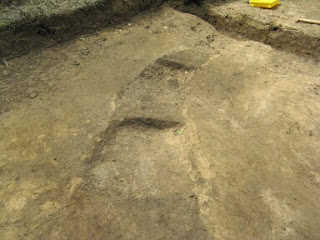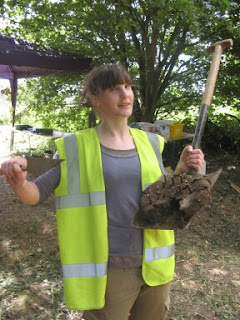Thanks to Mid-Nene Archaeological Group, a few young people from SAW got the chance to spend a day an excavation at a Roman site called Durobrivae, near Peterborough this summer.
Here are Oliver and Charlie's thoughts:
The last two Saturdays have been fantastic. On the first Saturday I was
excavating on a Roman road next to the Samian specialist Felicity Wild which was
fantastic to talk to her about Samian Ware pottery which I am very interested
in. There were three Samian specialists so I spent a lot of my time talking to
them which was fascinating. I didn't find much though and the experience of
digging the surface of the road was very hard work. The earth was very dry and
it eventually really hurt my wrists. I felt sorry for the archaeologists who had
had to dig there all of those weeks. On the second Saturday I was trying to find
the terminal end of a Roman Fort ditch. It was quite difficult to see the cut
and was quite frustrating when we were told we had to keep on digging down. But
what kept me going was all the finds. I found two pieces of Samian ( form 33 and
31) so the experts told me. I also found a piece of bronze sheet, no idea what
it was though, I personally think/hope it was a piece of armor. I had an
absolutely fantastic time, an experience I will never forget. Thank you to
Hellen and all the organizers that helped. It was fantastic.
Ollie
Picture 1 is my
Roman Coin that i uncovered.
Picture 2 is a
close up of the head of the coin.
Picture 3 is the
tails side of the coin.
Picture 4 is me
sifting through the soil.....hoping for another coin!
Picture 5 is the
Roman bracelet my mum and I found in our area. It is a bronze ladies bracelet.
Picture 6 is the
area beside the Roman road we excavated; they think it was an area of road that
sunk which was then used as a rubbish area (maybe to build up the sunken
hole).
Picture 7 and 8
John and me working on the fine detail of the hole.
Picture 9 was
one of the bucket on bones that we took out; the teeth are horses, the big bone
is cow. Alison a friend off my mums is an osteoarchaeologist and knows alot
about bones!!
Picture 10 is
the pig jaw that i uncovered.
Picture 11 is a
picture of the west site; where the two bucket are in the picture is where we
excavated.
It was very
exciting to work on our own area and get some great finds
my finds number
was number 100th find 40th coin and pit number 301.
103rd find 1st
bracelet and pit number 301.
They might end
up in a museum in Peterborough; they belong to English Heritage.
It was my first
ever coin soo i was very very excited and pleased about it......
I was allowed on
the last day to have a look at the spoils pile and were allowed to keep bits of
pottery I found.
I found some
Roman pottery. Just little bits show so much, rim shape, colours of glaze,
different clays used, patterns they used for decoration.
Charlie
 |
| Picture 1 |
 |
| Picture 2 |
 |
| Picture 3 |
 |
| Picture 4 |
 |
| Picture 5 |
 |
| Picture 6 |
 |
| Picture 8 |
 |
| Picture 7 |
 |
| Picture 10 |
 |
| Picture 9 |
 |
| Picture 11 |


















































+cmyk%5B1%5D.JPG)

